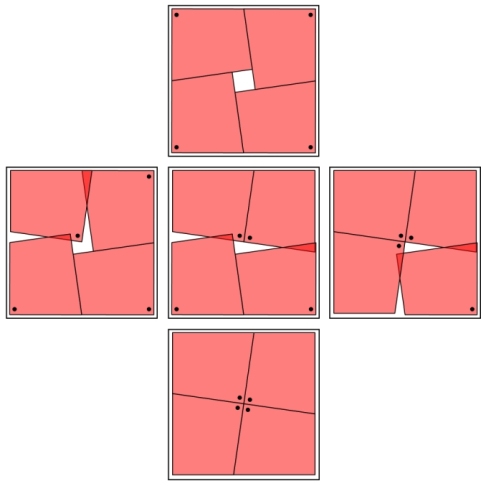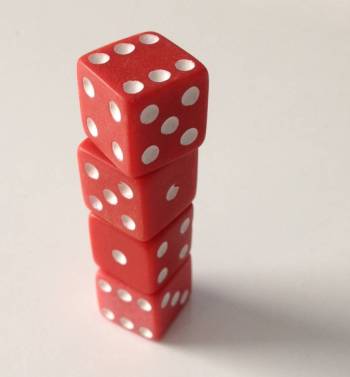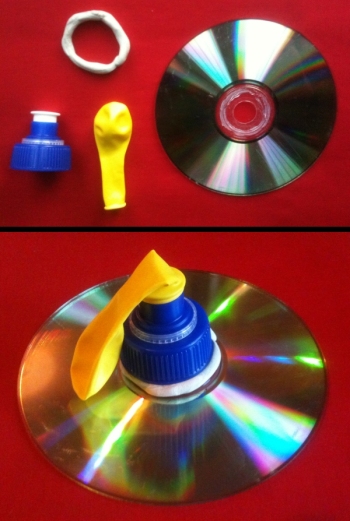What’s the effect?
The magician turns his back whilst the spectator stacks the dice up into a tower. The magician turns to face the audience and the spectator points to any of the dice in the stack (except for the top one because this is too easy). The magician then names the number on the top face of that dice even though it is hidden.
What you need?
What’s the method?
When you look at a die the maximum number of faces that you can see is 3. In this trick you are only going to be able to see 2 faces and from that information deduce what all the other faces are.
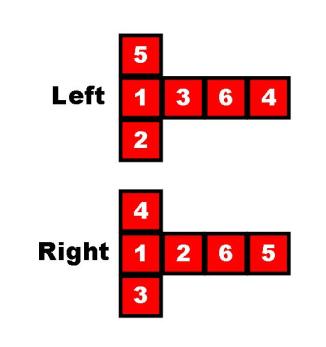
Dice have their faces arranged so that opposing sides always add up to 7 (i.e. 1&6; 2&5; 3&4). The Simple version of Dice towers makes use of this property. There are two possible arrangements of the numbers on a die that have this property (see the cube nets diagram). What I shall call left- and right-handed. They are mirror images of each other.
For what follows I’m using a left handed arrangement which in my experience is more common (the trick can be adapted for right handed dice by flipping all the rules below).
 I’ve come up with a method to calculate the remaining faces. It’s took a number of iterations to get it to a level where the method is fast and relatively easy to use. I’d love to know if you’ve got a better method or if I can describe it better.
I’ve come up with a method to calculate the remaining faces. It’s took a number of iterations to get it to a level where the method is fast and relatively easy to use. I’d love to know if you’ve got a better method or if I can describe it better.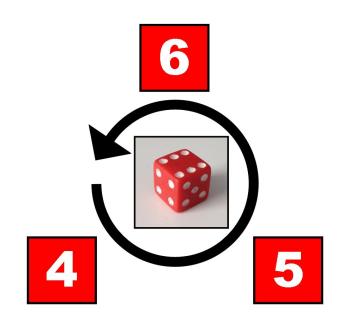
There are two cycles you need to be familiar with and these are illustrated in the two diagrams. Taking the 123 cycle as an example… If you see 1 on the left and 2 on the right, you know that 3 must be on top. Equally if you see 3 on the left and 1 on the right, then 2 is on top. This is just a simple rotation of the dice around the common corner. The same principle holds for the 456 cycle.
If you see the left and right numbers in reverse order (for example 2 on the left and 1 on the right) then the dice is upside down and 3 will now be on the bottom face. The top number is now 4 because it is on the opposite face.
So now we’ve got 2 rules to follow to make our calculation:
Rule A – If both the two numbers you can see on the left and right faces belong to the 123 or 456 cycle AND the faces are in numerical order then the TOP face will be the remaining number of that cycle.
Rule B – If both the two numbers you can see on the left and right faces belong to the 123 or 456 cycle AND the faces are in REVERSE numerical order then the BOTTOM face will be the remaining number of that cycle. The top number can be easily obtained from this information.
The question then arises what happens when the numbers on the left and right faces come from the different cycles (for example 1 and 5). You then need to do a little mental gymnastics. You need to switch in your head one of the numbers for its opposite so that the left and right faces are in reverse numerical order. In our example we have to switch the 1 for a 6 to make them in reverse numerical order. If we switched the 5 for a 2 it would be ascending order. Once we’ve decided which side to switch for its opposite, the final step is easy. As we’ve now got a 5 and 6 from the 456 cycle we know the top face is a 4.
Rule C – If both the two numbers you can see on the left and right faces DON’T belong to the 123 or 456 cycle then switch one of the numbers for it’s opposite so that the cycle is in REVERSE numerical order, then the TOP face is the remaining number in that cycle.
Here’s another example for rule C: Left = 2; Right = 6. The two numbers are from different cycles so we need to switch one number for it’s opposite. We switch 6 for 1 so that it’s in reverse numerical order. And now we’ve got a 1 and 2 from the 123 cycle and we can deduce the top number is a 3.

